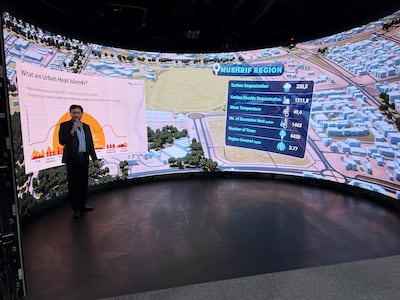IBM and Nasa have announced plans to work on a new artificial weather model to understand more about climate change and predict future weather events with greater accuracy.
The model will go beyond traditional forecasting and could solve larger climate challenges, while also improving the precision and speed of forecasts, the US company claims.
The announcement comes amid a rapid rise in AI-related weather research from various companies and agencies. IBM said its foundation model, compared with other efforts, incorporates the physics behind forecasting.
“This foundation model will go beyond forecasting to solve larger climate challenges, along the way promising improvements in precision, speed and cost-effectiveness,” IBM said.
Saad Toma, general manager for IBM Middle East and Africa said: “Foundation models, which are trained on geospatial information such as satellite images, present a unique opportunity to address climate change because unlike traditional AI models tailored for specialised tasks, geospatial foundation models – encompassing satellite and weather data – create knowledge representations from petabytes and exabytes of climate-relevant data that can accelerated and streamlined discovery of environmental insights and solutions.”
US author Parag Khanna reflected on overall AI efforts in the meteorological and climatology space amid the IBM announcement.
Mr Khanna’s company Climate Alpha, works with AI-powered analytics to navigate “climate volatility” and future-proof global investment.
“They’re extremely useful [AI models] for localised short-term resilience measures – early warning systems for example, and also managing crop planting patterns, or the volatility of monsoons, all of these things, it’s better to know than not to know for responding and reacting,” he said.
IBM's climate-related weather partnership with Nasa comes as the much-anticipated Cop28 climate conference gets under way in Dubai, with various companies, agencies and NGOs seeking to leave their mark amid government efforts to solve the climate crisis.
More than 97,000 delegates have registered for Cop28, and more than 400,000 people overall are expected to take part in the conference in Dubai, according to organisers.
AI has been seen by some as a potential way to help identify climate solutions, while others have taken a more cautious approach to the fast-evolving AI landscape.
In October, at the World Economic Forum’s Global Future Councils annual meeting, Stuart Russell, professor of computer science at the University of California, Berkeley, cautioned against banking all climate hopes on AI.
“It might help around the edges,” he said. “But the climate is really a collective action problem. We know what to do but we’re not doing it.”
IBM said it will also be collaborating with Mohamed Bin Zayed University of Artificial Intelligence (MBZUAI) in Abu Dhabi, the world's first university to have a singular focus on AI, to use IBM's geospatial AI technology to analyse urban heat islands in the UAE.

The Urban Heat Islands Effect is a phenomenon in which cities become hotter than the natural landscape that surrounds them, which in turn, can have a significant effect on the sustainability of communities.
IBM and MBZUAI’s efforts will attempt to apply foundation models to the mapping of such heat islands and better understand their formation, according to IBM.
“This first-of-a-kind research specifically applies a fine-tuned version of IBM’s geospatial foundation model to understand the urban environment in Abu Dhabi and how the underlying landscape in the UAE impacts the formation of urban heat islands,” it said.






